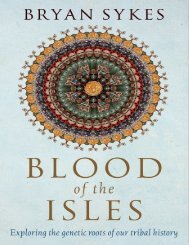You also want an ePaper? Increase the reach of your titles
YUMPU automatically turns print PDFs into web optimized ePapers that Google loves.
In 1871, Lord Kelvin, the most eminent physicist of his day, posed a serious objection to Darwin’s<br />
theory. It had not been answered by Darwin, or anyone else, in subsequent years.<br />
Whatever else one might think of evolutionary theory, it obviously implied a substantial period of<br />
time—at least several hundred thousand years—to carry out its effects on earth. At the time of<br />
Darwin’s publication, the oldest estimates of the age of the earth were around ten thousand years.<br />
Darwin himself believed the earth would have to be at least three hundred thousand years old to<br />
allow enough time for evolution. The earthly evidence, from the new study of geology, was confusing<br />
and contradictory, but it seemed at least conceivable that the earth might be several hundred thousand<br />
years old.<br />
Lord Kelvin took a different approach to the question. He asked how long the sun had been burning.<br />
At this time, the mass of the sun was well established; it was obviously burning with the same<br />
processes of combustion as were found on earth; therefore one could estimate the time it would take<br />
to consume the mass of the sun in a great fire. Kelvin’s answer was that the sun would burn up<br />
entirely within twenty thousand years.<br />
The fact that Lord Kelvin was a devoutly religious man and therefore opposed to evolution could<br />
not be thought to have biased his thinking. He had investigated the problem from the impersonal<br />
vantage point of mathematics and physics. And he had concluded, irrefutably, that there was simply<br />
not enough time for evolutionary processes to take place.<br />
Corroborating evidence derived from the warmth of the earth. From mine shafts and other drilling,<br />
it was known that the earth’s temperature increased one degree for every thousand feet of depth. This<br />
implied that the core of the earth was still quite hot. But if the earth had really formed hundreds of<br />
thousands of years ago, it would have long since become cool. That was a clear implication of the<br />
second law of thermodynamics, and there was no disputing it.<br />
There was only one escape from these physical dilemmas, and Cope echoed Darwin in suggesting<br />
it. “Perhaps,” he said, “we do not know everything about the energy sources of the sun and the earth.”<br />
“You mean there may be a new form of energy, as yet unknown to science?” Morton asked. “The<br />
physicists say that it is impossible, that the rules governing the universe are fully understood by<br />
them.”<br />
“Perhaps the physicists are wrong,” Cope said.<br />
“Certainly someone is wrong.”<br />
“That is true,” Cope said evenly.<br />
If he was open-minded when listening to Morton’s beliefs, he was equally so with Little Wind, the<br />
Snake scout.<br />
Early in the bone digging, Little Wind became agitated and objected to their excavations. He said<br />
they would all be killed.<br />
“Who will kill us?” Sternberg inquired.<br />
“The Great Spirit, with lightning.”<br />
“Why?” Sternberg asked.<br />
“Because we disturb the burial ground.”<br />
Little Wind explained that these were the bones of giant snakes that had inhabited the earth in ages<br />
past, before the Great Spirit had hunted them down and killed them all with bolts of lightning so that<br />
man could live on the plains.<br />
The Great Spirit would not want the serpent bones disturbed, and would not look kindly on their<br />
adventures.<br />
Sternberg, who did not like Little Wind anyway, duly reported it to Cope.
















